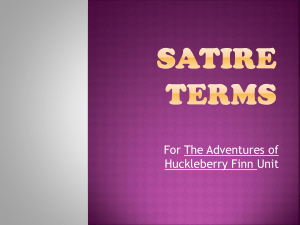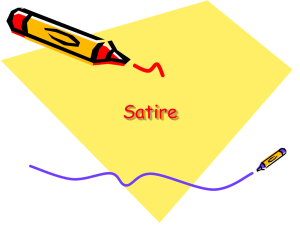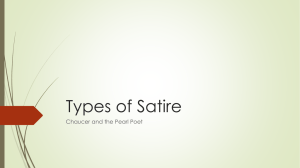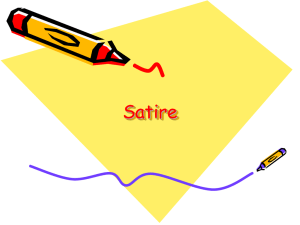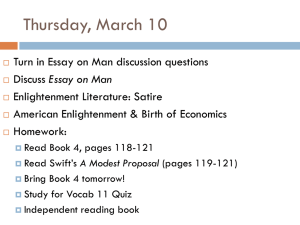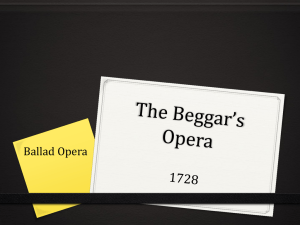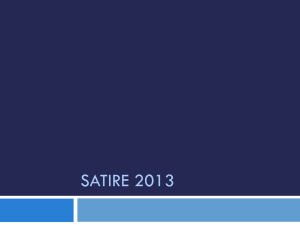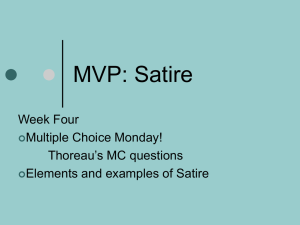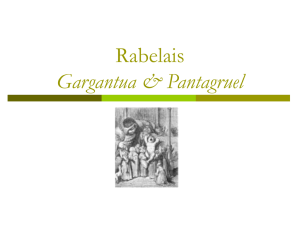satire notes
advertisement
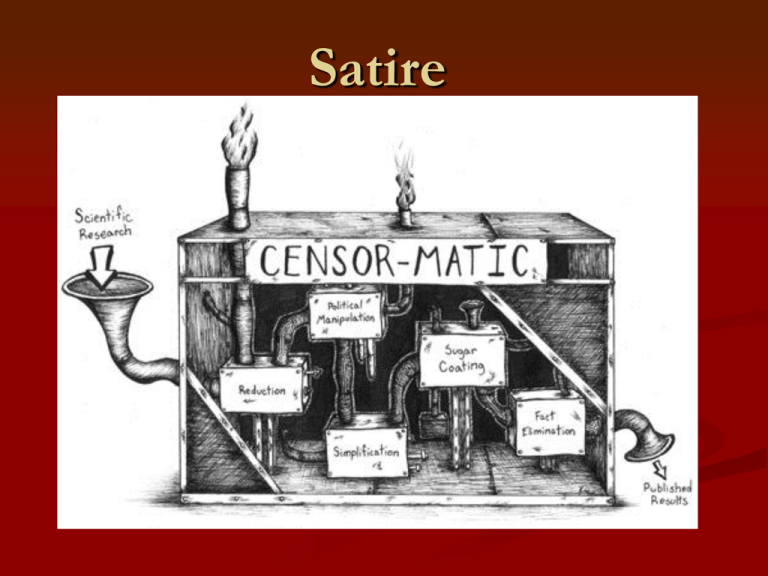
Satire Definition A literary work that ridicules its subject in order to make a comment or criticism about it. Although satire is usually witty, and often very funny, the purpose of satire is to criticize in order to shame someone or something into reform. Satire usually has a definite target, which may be a person or group of people, an idea or attitude, an institution, or a social practice. First Type of Satire: Formal In formal satire, the satiric voice speaks, usually in the first person, either directly to the reader or to a character in the written work. There are two types of formal satire: Horatian and Juvenalian Horatian Satire Horatian Satire, named for the Roman poet, Horace, is gentle, urbane, smiling; it aims to correct through gentle and sympathetic laughter. Horatian Satire Juvenalian Satire Juvenalian Satire, named for the Roman poet Juvenal, is biting, bitter, angry; it points with contempt and moral indignation to the corruption and evil of human beings and institutions. Juvenalian Satire What is Juvenalian Satire? “I would never let a woman kick my ass. If she tried something, I'd be like, HEY! You get your bitch ass back in the kitchen and make me some pie!” – Eric Cartman Of the two forms of satire, it is the Juvenalian that most effectively gets people’s attention. South Park is one of the best examples of Juvenalian satire, poking fun at everything from politics and celebrities to religions and everyday life. The opening quote demonstrates how the show takes a serious issue such as equality and misogyny, and turns it into a joke or even an insult. This is the hallmark of Juvenalian satire: using sharp sarcasm to criticize social issues. Juvenalian satirists seek to push the boundary of tolerance in their audience. They typically address social mores, which are more serious than folkways. Unlike Horatian satire there is less emphasis on humor and a larger emphasis on morals. Second Type of Satire Indirect Satire: In indirect satire, the satire is expressed through a narrative, and the characters or groups who are the focus of the satire are ridiculed not by what is said about them, but by what they themselves say and do. Much of the great literary satire is indirect. Examples of Indirect Satire: The Simpsons Family Guy South Park Brave New World Great Expectations Scary Movie 1, 2 and 3 Chappelle’s Show Clueless Saturday Night Live MAD TV. Naked Gun The Truman Show Scrubs Huckleberry Finn Questions to Consider What is the author’s tone? What is the author’s purpose? Is it effective? What is the dominant satirical device used? Four Techniques of Satire 1. Exaggeration To enlarge, increase, or represent something beyond normal bounds so that it becomes ridiculous and its faults can be seen. 2. Incongruity To present things that are out of place or are absurd in relation to their surroundings. 3. Reversal To present the opposite of the normal order (e.g., the order of events hierarchical order). 4. Parody To imitate the techniques and/or style of some person, place or thing. Exaggeration Incongruity Reversal Parody Horation or Juvenalian? Horation or Juvenalian? Which of the four types? Horation or Juvenalian? Horation or Juvenalian? Horation or Juvenalian? Horation or Juvenalian? Which of the four types? Which of the four types? Which of the four types? Which of the four types? Which of the four types?
